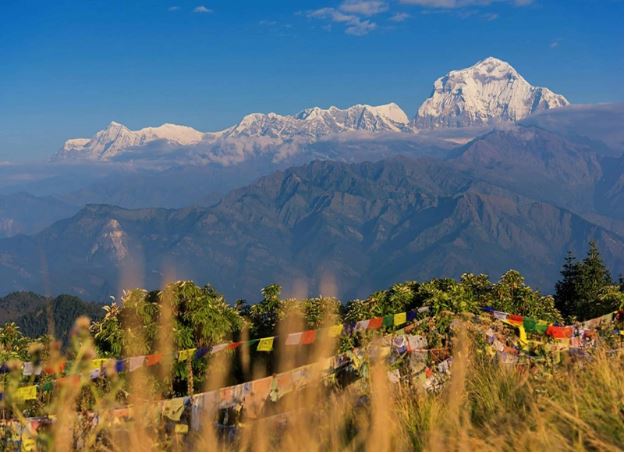Want to try Himalayan trekking but feel nervous about altitude and distance? Poon Hill trek gives you mountain views without extreme challenges. This short route in Annapurna region draws thousands of new hikers each year. You climb to 3,210 meters and see sunrise over giant peaks.
Most beginners worry about their first mountain adventure. Will I handle altitude? Can my body take daily walks? Poon Hill answers these questions gently. You build confidence on well-marked paths with good facilities.
Short Duration Fits Busy Schedules
Poon Hill trekking takes only 4-5 days. You start from Nayapul after driving from Pokhara. Walk through Tikhedhunga, climb to Ghorepani, reach Poon Hill viewpoint, then descend through Tadapani or Ghandruk. Total trip wraps up in less than one week.
Compare this to Annapurna Base Camp, which needs 7-10 days. Everest Base Camp demands 12-14 days minimum. Busy people struggle to take long breaks. Poon Hill fits standard vacation time. You fly in, trek, and fly out within 10 days total including Kathmandu.
Short distance means less physical demand. Your body adjusts easier. Muscles don’t break down as much. Mental fatigue stays low. You finish feeling accomplished, not exhausted.
Gentle Altitude Gain Reduces Risks
Altitude sickness scares first-time trekkers. Poon Hill summit sits at 3,210 meters. Most people handle this height without problems. You sleep at Ghorepani village (2,874 meters) before sunrise hike. Your body gets time to adjust.
Compare this to higher treks. Annapurna Base Camp reaches 4,130 meters. Everest Base Camp hits 5,364 meters. These heights bring serious altitude risks. Headaches, nausea, and breathing trouble affect many hikers.
Poon Hill lets you test your altitude response safely. You learn how your body reacts to thin air. This knowledge helps plan bigger treks later. Start small. Build experience. Move to higher peaks when ready.
Medical help stays accessible on Poon Hill route. Ghorepani has health posts. Helicopter rescue works easily from this area. Villages dot your path every few hours. You never walk far from assistance.
Well-Developed Trail Infrastructure
Poon Hill trek follows established paths. Stone steps make steep sections easier. Bridges cross rivers safely. Trail markers prevent wrong turns. Thousands walk this route yearly, keeping paths clear and obvious.
Tea houses line your route every 30-60 minutes. These lodges offer beds, food, and warm drinks. Rooms stay basic but clean. Shared bathrooms work fine for short trips. Hot showers cost extra but feel amazing after hiking.
Menu choices surprise new trekkers. You find dal bhat (rice and lentils), noodle soups, fried rice, pancakes, and even pizza. Western food helps if Nepali meals upset your stomach. Tea, coffee, and hot chocolate warm cold mornings.
Electricity reaches most tea houses. Charge phones and cameras for small fees. WiFi exists in larger villages like Ghorepani and Ghandruk. Connection speed frustrates sometimes but works for basic messages home.
Stunning Mountain Views Reward Effort
Sunrise from Poon Hill viewpoint stuns everyone. Dhaulagiri (8,167 meters) glows orange to your left. Annapurna South, Annapurna I, and Machhapuchhre (Fishtail) line up ahead. Nilgiri peaks rise to your right. Over 20 major summits appear in one panorama.
Photography fans go crazy here. Golden light hits white peaks. Colors shift from pink to orange to bright white as sun climbs. Everyone snaps hundreds of photos. Professional cameras and phone cameras both capture magic.
Mountain views continue throughout your trek. Annapurna South dominates southern horizons. Machhapuchhre’s pyramid shape identifies easily. You see these giants from multiple angles as you walk.
Lower elevation views matter too. Terraced fields create green and gold patterns. Villages cling to hillsides. Rivers carve deep valleys. Rhododendron forests explode with color in spring. Every section brings new sights.
Cultural Encounters Enrich Your Journey
Poon Hill trail passes through Gurung and Magar villages. These ethnic groups maintain traditional lifestyles. Stone houses with slate roofs cluster together. Prayer flags flutter from rooftops. Water buffalo graze near homes.
Ghandruk village offers deep cultural experiences. Visit Gurung museum to learn local history. Watch women weave traditional cloth. Buy handmade crafts directly from makers. Village hospitality warms your heart.
Children wave and shout greetings as you pass. Older people sit outside homes, offering smiles. Tea house owners share stories about mountain life. You learn about farming, festivals, and family traditions.
Buddhist prayer wheels line some trail sections. Spin them clockwise as you walk. Monasteries welcome visitors for quiet moments. Hindu temples mark village centers. Religious diversity teaches tolerance and respect.
Affordable Budget Suits First-Time Trekkers
Poon Hill trekking costs less than longer routes. Tea house accommodation runs $3-8 per night. Meals cost $3-6 each. Daily expenses stay under $25-35 including lodging, food, and drinks.
Permits add to costs but stay reasonable. TIMS card (Trekkers’ Information Management System) costs around $20. Annapurna Conservation Area Permit runs about $30. Total permit fees hit roughly $50.
Guide and porter services remain optional. Solo trekking works fine on this well-marked route. Hiring guide costs $25-30 daily. Porter fees run $20-25 per day. These helpers enhance experience but aren’t required for safety.
Compare this to remote area permits costing hundreds of dollars. Or Everest region expenses that double due to flights and higher prices. Poon Hill lets you test Himalayan trekking without major financial commitment.
Year-Round Access Offers Flexibility
Poon Hill trek works in every season. Spring (March-May) brings rhododendron blooms and clear skies. Autumn (September-November) delivers perfect weather and excellent visibility. Summer monsoon (June-August) means rain but fewer crowds. Winter (December-February) brings cold and some snow but stunning clarity.
Most people choose spring or autumn. Weather stays stable. Views appear sharp. Tea houses run at full capacity. Trails get busy but never overcrowded like popular Everest routes.
Winter trekking builds character. Cold tests your gear and determination. Snow adds beauty. Nearly empty trails give private mountain experiences. Tea houses stay open year-round in main villages.
Monsoon attracts adventurous souls. Rain falls mostly afternoons. Morning walks stay drier. Lush greenery covers hillsides. Waterfalls roar with power. Discounted accommodation saves money.
Training Requirements Stay Minimal
Poon Hill needs basic fitness, not athlete conditioning. Walk 4-6 hours daily on stairs or hills for few weeks before your trip. Build leg strength and breathing capacity. No gym membership required.
Daily distances stay manageable. Longest day covers maybe 6-7 hours including breaks. Most days take 4-5 hours. You walk slowly, enjoying scenery and taking photos. Rush serves no purpose.
Age limits don’t exist. Children as young as 8 complete this trek successfully. Seniors in their 70s finish with smiles. Physical condition matters more than birth year. Listen to your body. Rest when tired. Drink lots of water.
Previous trekking experience helps but isn’t necessary. This route teaches basics. You learn proper pacing. Discover what gear works. Understand altitude effects. Test your mental stamina. All lessons transfer to bigger adventures later.
Gateway to Bigger Himalayan Dreams
Poon Hill serves as stepping stone to longer treks. Success here builds confidence for Annapurna Base Camp. That accomplishment leads toward Everest Base Camp or Manaslu Circuit. Each trek teaches new skills.
You discover personal limits safely. Learn what fitness level you need. Figure out gear preferences. Understand how altitude affects you. Test food tolerance. These insights guide future trip planning.
Meeting other trekkers opens possibilities. Swap stories and recommendations. Find future hiking partners. Learn about routes you never knew existed. Mountain community welcomes new members warmly.
Guide relationships often continue for years. Hire same guide for next adventure. They know your pace and preferences. Trust builds over multiple trips. Many trekkers become lifelong friends with Nepali guides.
Start Your Himalayan Journey
Poon Hill trek removes barriers keeping people from mountains. Short duration fits schedules. Low altitude reduces risks. Good facilities ease concerns. Affordable prices welcome budget travelers. Stunning views reward every step.
Stop wondering if you can handle Himalayan trekking. Poon Hill proves you can. Book your trip. Pack your bag. Lace up boots. Those sunrise views over Annapurna range wait for you.
Your mountain story begins with one decision: Will you take this first step?








